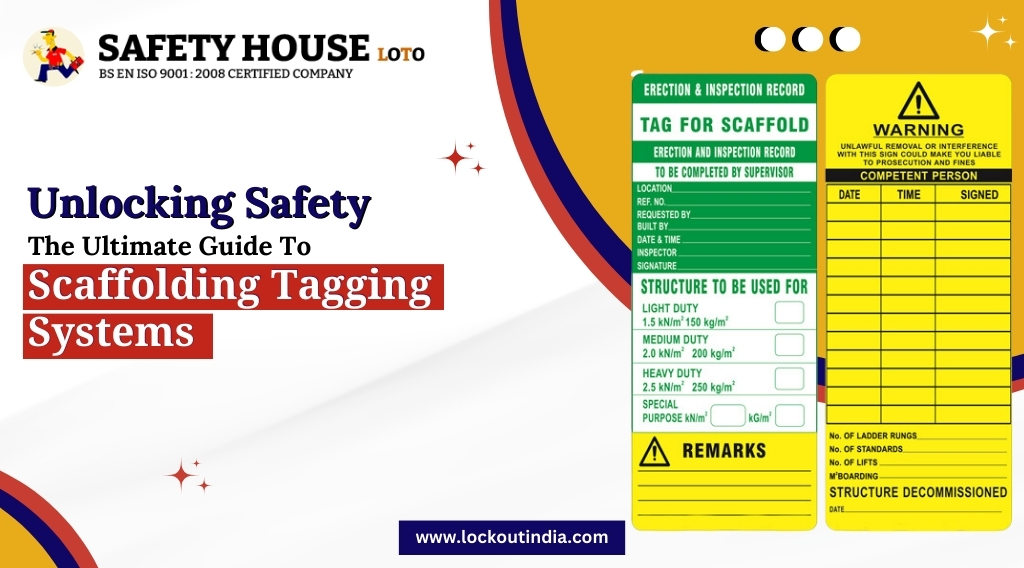
Unlocking Safety: The Ultimate Guide to Scaffolding Tagging Systems
Introduction:
In the realm of construction and industrial settings, safety is paramount. Scaffolding, a ubiquitous fixture in such environments, demands rigorous safety protocols to protect workers and prevent accidents. Enter scaffolding tagging systems, a vital component of safety procedures. In this comprehensive guide, we delve into the intricacies of scaffolding tag systems, their importance, implementation, and best practices.
What is a Scaffolding Tag?
A scaffolding tag is a visual indicator affixed to scaffolding structures, providing crucial information about its safety status and usage guidelines. Typically, these tags consist of color-coded segments and pertinent details such as inspection dates, safety precautions, and load-bearing capacities.
Importance of Scaffolding Tagging Systems:
- Enhanced Safety Awareness: Scaffolding tags serve as a constant reminder of safety protocols, fostering a culture of awareness among workers and supervisors.
- Compliance with Regulations: Regulatory bodies mandate the use of scaffolding tagging systems to ensure adherence to safety standards and regulations.
- Risk Mitigation: By clearly indicating the status of scaffolding structures, tags help identify potential hazards and mitigate risks before accidents occur.
- Efficient Maintenance: Regular inspections facilitated by scaffolding tags enable timely maintenance and repairs, prolonging the lifespan of scaffolding equipment.
- Accountability and Documentation: Tags provide a documented record of inspections, demonstrating compliance with safety regulations and liability in case of incidents.
Components of a Scaffolding Tag:
- Color-Coded Segments: Tags often feature color-coded segments to indicate the scaffolding’s safety status. Common colors include green for safe, yellow for caution, and red for unsafe.
- Inspection Details: Tags display essential information such as inspection dates, inspector signatures, and any identified issues or recommendations.
- Usage Guidelines: Instructions regarding maximum load capacities, prohibited activities, and safety precautions are prominently featured on scaffolding tags.
- Contact Information: Tags may include contact details for reporting safety concerns or seeking clarification on usage guidelines.
Implementing Scaffolding Tagging Systems:
- Training and Education: Ensure that all personnel involved in scaffolding operations receive comprehensive training on the significance of scaffolding tags and how to interpret them.
- Standardized Procedures: Develop standardized procedures for tagging scaffolding structures, including inspection frequencies, documentation requirements, and protocols for addressing identified issues.
- Quality Assurance: Regularly audit scaffolding tagging systems to verify compliance with established procedures and identify areas for improvement.
- Collaboration with Regulatory Bodies: Work closely with relevant regulatory bodies to stay abreast of updated safety regulations and ensure alignment with scaffolding tagging practices.
Best Practices for Scaffolding Tagging Systems:
- Frequent Inspections: Conduct regular inspections of scaffolding structures, adhering to predetermined schedules and documented procedures.
- Clear Communication: Ensure that scaffolding tags are prominently displayed and easily visible to workers, supervisors, and inspectors.
- Immediate Action on Red Tags: Red tags indicating unsafe conditions should prompt immediate corrective action, including cessation of work until issues are resolved.
- Documentation and Record-Keeping: Maintain detailed records of inspections, including dates, findings, corrective actions taken, and signatures of inspectors.
- Continuous Improvement: Solicit feedback from workers and inspectors to identify opportunities for enhancing the effectiveness of scaffolding tagging systems and safety protocols.
Conclusion:
In the dynamic landscape of construction and industrial environments, safety remains an indispensable priority. Scaffolding tagging systems, like those provided by Safety House Loto, serve as a cornerstone of safety protocols, providing essential information and visual cues to safeguard workers and prevent accidents. By understanding the importance, components, implementation strategies, and best practices of scaffolding tag systems, organizations can foster a culture of safety, compliance, and accountability. Unlock the potential of safety with robust scaffolding tagging systems from Safety House Loto, ensuring a secure and productive work environment for all.
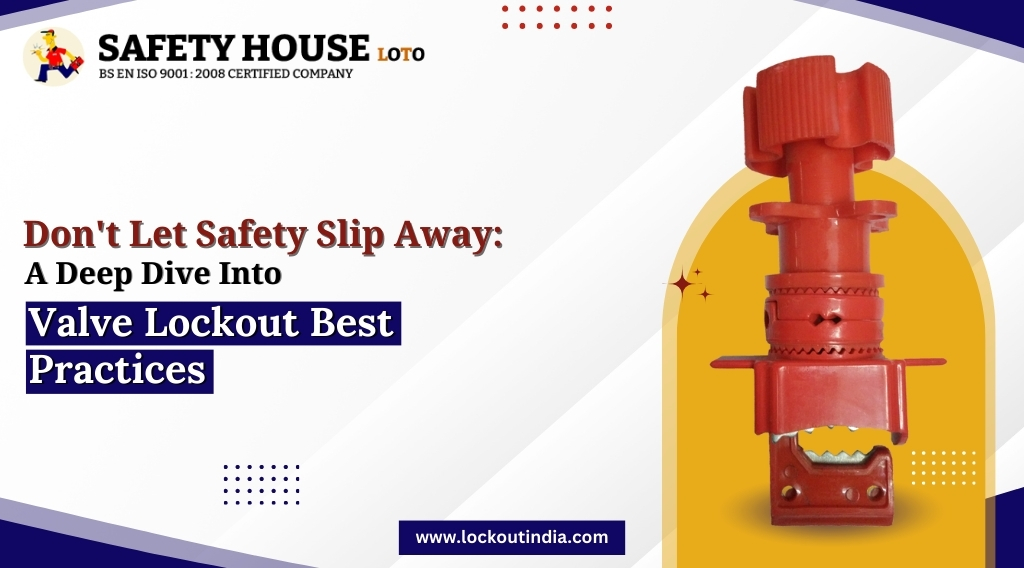
Don’t Let Safety Slip Away: A Deep Dive into Valve Lockout Best Practices
Ensuring Workplace Safety: A Close Examination of Valve Lockout Strategies
In industries where hazardous materials flow through pipelines, valves serve as crucial control points. These valves regulate the flow of liquids, gases, and other substances, ensuring smooth operation. However, when it comes to maintenance, repair, or any situation requiring valve isolation, ensuring safety becomes paramount. This is where valve lockout procedures play a vital role.
Understanding Valve Lockout
Valve lockout is a safety procedure designed to prevent the accidental or unauthorized opening of valves during maintenance or repair work. By using specialized lockout devices, such as padlocks, hasps, and tags, valves are physically locked in a closed or open position, depending on the situation. This prevents unexpected release of hazardous substances, which could lead to accidents, injuries, or environmental damage.
Importance of Valve Lockout
The importance of valve lockout cannot be overstated in industries where safety is a top priority. Failure to properly lock out valves during maintenance or repair activities can result in catastrophic consequences, including chemical spills, fires, explosions, and even loss of life. Therefore, implementing robust valve lockout procedures is essential for protecting personnel, equipment, and the environment.
Key Components of Valve Lockout
A successful valve lockout program consists of several key components:
- Lockout/Tagout (LOTO) Procedures: Comprehensive LOTO procedures should be developed and followed for each valve isolation task. These procedures should include detailed instructions on how to properly lock out valves, including the use of lockout devices and tags.
- Training and Education: Proper training and education are essential for all personnel involved in valve lockout procedures. Employees should be trained on the importance of valve lockout, how to identify lockout points, and how to use lockout devices correctly.
- Lockout Devices: Choosing the right lockout devices is crucial for effective valve lockout. Devices should be durable, tamper-resistant, and capable of withstanding the operating environment. Common lockout devices include valve lockout hasps, ball valve lockouts, and gate valve lockouts.
- Lockout Tags: Lockout tags provide essential information about the status of the valve and the reason for its lockout. Tags should be prominently displayed and include details such as the name of the authorized employee, the date of lockout, and any specific hazards associated with the valve.
Best Practices for Valve Lockout
To ensure the effectiveness of valve lockout procedures, the following best practices should be followed:
- Perform a Risk Assessment: Before initiating any valve lockout procedure, conduct a thorough risk assessment to identify potential hazards and determine the appropriate lockout measures.
- Use Standardized Procedures: Develop standardized lockout procedures for different types of valves and isolation tasks. Ensure that all employees are familiar with these procedures and follow them consistently.
- Implement a Lockout/Tagout Program: Integrate valve lockout procedures into a comprehensive Lockout/Tagout (LOTO) program to ensure consistency and compliance with regulatory requirements.
- Provide Adequate Training: Train all personnel involved in valve lockout procedures on the proper use of lockout devices, the importance of following procedures, and the potential consequences of failure to lock out valves.
- Regular Inspections and Audits: Conduct regular inspections and audits to ensure that valve lockout procedures are being followed correctly. Address any deficiencies or non-compliance issues promptly.
Compliance with Regulations
Compliance with relevant regulations and standards is essential for ensuring the effectiveness of valve lockout procedures. In the United States, the Occupational Safety and Health Administration (OSHA lock) has established specific requirements for lockout/tagout procedures under 29 CFR 1910.147. Similarly, other regulatory bodies around the world have their own guidelines governing lockout procedures. It is imperative for organizations to familiarize themselves with these regulations and ensure compliance to avoid penalties and legal consequences.
Conclusion
Valve lockout is a critical safety procedure that plays a vital role in preventing accidents, injuries, and environmental damage in industries where hazardous materials are present. By implementing robust lockout procedures, providing adequate training, and ensuring compliance with regulations, organizations can protect their personnel, equipment, and the environment from potential harm. Remember, safety should never be compromised, and valve lockout is a crucial step in safeguarding against unforeseen hazards.
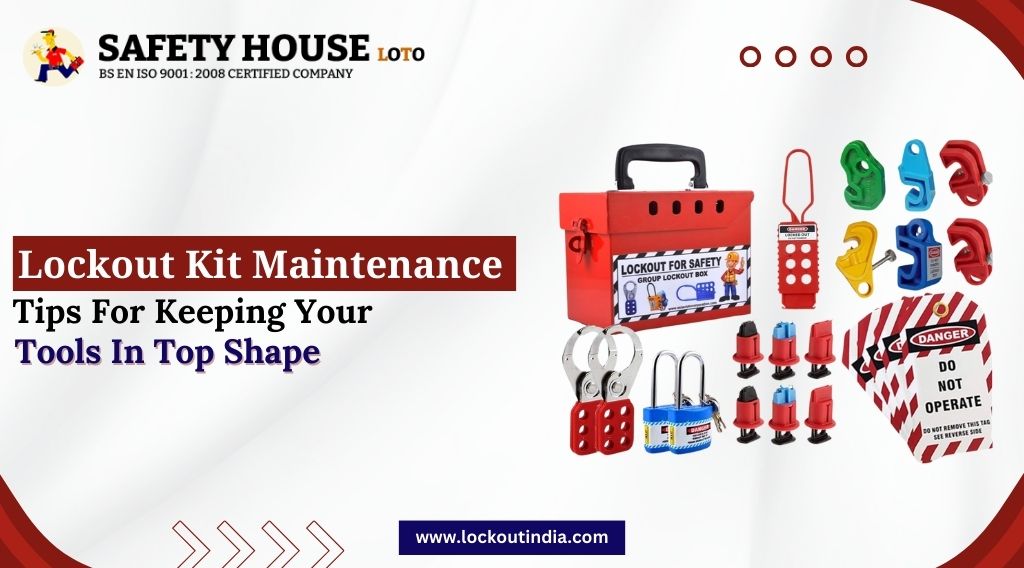
Lockout Kit Maintenance: Tips for Keeping Your Tools in Top Shape
Essential Tips for Maintaining Your Lockout Kit
Introduction:
A lockout kit serves as a cornerstone of safety protocols in industrial environments, providing essential tools for controlling hazardous energy sources during maintenance or repair tasks. However, ensuring the effectiveness of these kits requires regular maintenance and upkeep. In this article, we’ll explore the importance of lockout kit maintenance and provide valuable tips for keeping your tools in top shape, enhancing workplace safety and compliance.
Understanding Lockout Kits:
Before delving into maintenance tips, let’s first understand what comprises a lockout kit. Typically, a lockout kit contains a variety of devices and accessories designed to isolate energy sources and prevent the accidental or unauthorized startup of machinery or equipment. Common components include padlocks, lockout hasps, tags, circuit breaker lockouts, valve lockouts, and other specialized devices tailored to different types of energy sources.
The Importance of Lockout Kit Maintenance:
Lockout kit maintenance is vital for ensuring the reliability and effectiveness of safety measures in the workplace. Regular upkeep helps identify and address issues such as damaged or worn-out components, ensuring that lockout devices function as intended when needed. By maintaining lockout kits in optimal condition, businesses can minimize the risk of accidents, protect workers, and maintain compliance with regulatory standards.
Tips for Lockout Kit Maintenance:
- Regular Inspections: Conduct periodic inspections of lockout kits to check for signs of damage, wear, or corrosion. Inspect each component thoroughly, paying attention to padlocks, hasps, tags, and lockout devices for any defects or malfunctioning parts.
- Replace Worn-Out Components: Replace any worn-out or damaged components promptly to ensure the integrity of the lockout kit. This includes replacing padlocks with broken shackles, worn-out tags, or damaged lockout devices to maintain effectiveness and reliability.
- Clean and Lubricate: Clean lockout devices regularly to remove dirt, debris, or contaminants that may impair their functionality. Apply lubricants to moving parts such as hinges and locking mechanisms to ensure smooth operation and longevity.
- Store Properly: Proper storage is essential to prevent damage and prolong the lifespan of lockout kits. Store kits in designated areas away from harsh environmental conditions, extreme temperatures, moisture, or direct sunlight.
- Update and Expand: Periodically review and update lockout kits to ensure they remain relevant and effective for the equipment and energy sources present in the workplace. Consider expanding kits to accommodate new machinery or equipment additions.
- Employee Training: Provide comprehensive training to employees on proper lockout kit maintenance procedures. Educate workers on the importance of inspecting, cleaning, and replacing components as part of their safety responsibilities.
- Document Maintenance Activities: Maintain detailed records of lockout kit maintenance activities, including inspection dates, component replacements, and any issues identified and addressed. Documentation helps track maintenance history and ensures accountability.
- Seek Professional Assistance: If unsure about maintenance procedures or encountering complex issues with lockout kits, seek assistance from qualified professionals or manufacturers for guidance and support.
Conclusion:
Lockout kit maintenance is essential for ensuring the effectiveness of safety measures in industrial environments. By following the tips outlined above, businesses can keep their lockout kits in top shape, enhancing workplace safety, minimizing the risk of accidents, and maintaining compliance with regulatory standards. Remember, proactive maintenance is key to safeguarding workers and promoting a culture of safety in the workplace.
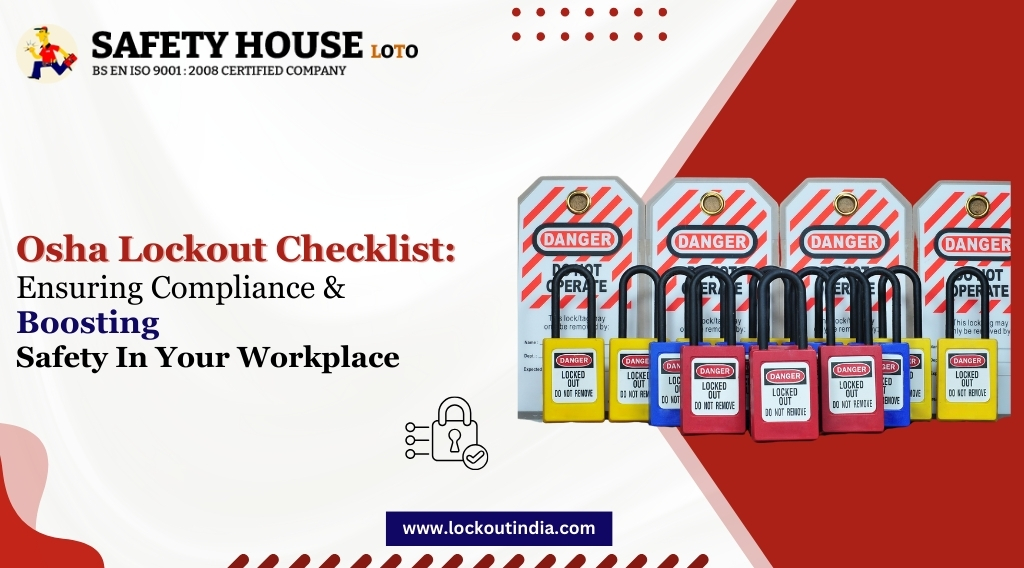
OSHA Lockout Checklist: Ensuring Compliance and Boosting Safety in Your Workplace
OSHA Lockout Checklist for Workplace Safety
Introduction:
In today’s industrial landscape, prioritizing safety measures is paramount to ensure the well-being of workers and compliance with regulatory standards. The Occupational Safety and Health Administration (OSHA) plays a crucial role in setting guidelines and regulations to maintain workplace safety. One such vital aspect regulated by OSHA is lockout procedures, aimed at preventing hazardous energy releases during maintenance or servicing activities. This article delves into the significance of OSHA lockout procedures, the importance of compliance, and how implementing a comprehensive lockout checklist can bolster safety in the workplace.
Understanding OSHA Lockout:
OSHA lockout refers to the set of procedures designed to control hazardous energy sources, such as electrical, mechanical, hydraulic, pneumatic, chemical, and thermal energy, to prevent unexpected startup or release of stored energy. These procedures mandate the use of lockout devices to isolate energy sources and ensure equipment remains inoperative during maintenance or repair tasks. Adhering to OSHA standards not only mitigates the risk of workplace accidents but also fosters a culture of safety within the organization.
The Importance of OSHA Lockout Compliance:
Compliance with OSHA lockout regulations is non-negotiable for businesses operating in industrial settings. Failure to adhere to these standards can result in severe consequences, including fines, penalties, and, most importantly, jeopardizing the safety of workers. By complying with OSHA lock requirements, companies demonstrate their commitment to workplace safety, protecting employees from potential hazards and ensuring regulatory adherence.
Key Elements of an OSHA Lockout Checklist:
Creating and implementing an OSHA lockout checklist is instrumental in ensuring compliance and enhancing safety protocols within the workplace. Below are the key elements to include in a comprehensive lockout checklist:
- Identification of Energy Sources: Begin by identifying all energy sources present in the workplace, including electrical, mechanical, and pneumatic systems. Conduct a thorough assessment to pinpoint potential hazards and determine the necessary lockout procedures for each energy source.
2. Lockout Device Selection: Select appropriate lockout devices suitable for isolating each energy source effectively. Ensure lockout devices are durable, tamper-resistant, and compatible with the equipment being serviced.
3. Employee Training and Awareness: Provide comprehensive training to employees on OSHA lockout procedures, emphasizing the importance of proper lockout/tagout (LOTO) practices. Employees should be proficient in identifying energy sources, applying lockout devices, and understanding the significance of LOTO protocols for their safety.
4. Documentation and Procedures: Develop clear and concise lockout/tagout procedures outlining step-by-step instructions for implementing lockout measures. Maintain detailed documentation of lockout procedures, including equipment-specific instructions and authorized personnel responsible for performing lockout tasks.
5. Periodic Inspections and Audits: Conduct regular inspections and audits to ensure compliance with lockout procedures and identify any deviations or shortcomings. Address any deficiencies promptly and revise lockout procedures as necessary to maintain effectiveness.
6. Communication and Signage: Implement clear communication protocols and signage to alert employees of ongoing lockout activities and the status of equipment undergoing maintenance. Use standardized lockout tags and labels to indicate the presence of lockout devices and provide instructions for safe operation.
Benefits of Implementing an OSHA Lockout Checklist:
Implementing an OSHA lockout checklist offers numerous benefits for businesses, including:
- Enhanced Workplace Safety: By following standardized lockout procedures, businesses can effectively control hazardous energy sources and reduce the risk of workplace accidents.
- Compliance with Regulatory Standards: Adhering to OSHA lockout regulations ensures compliance with legal requirements, mitigating the risk of fines and penalties.
- Prevention of Equipment Damage: Proper lockout procedures prevent unauthorized operation of equipment during maintenance, minimizing the risk of damage or malfunction.
- Protection of Personnel: Lockout procedures safeguard workers from potential injuries caused by unexpected energy releases or equipment startup.
- Establishment of Safety Culture: Implementing robust lockout protocols fosters a culture of safety within the organization, promoting awareness and accountability among employees.
Conclusion:
In conclusion, OSHA lockout procedures are critical for maintaining workplace safety and compliance with regulatory standards. Implementing an OSHA lockout checklist is essential for identifying energy sources, selecting appropriate lockout devices, providing employee training, documenting procedures, conducting inspections, and fostering effective communication. By prioritizing OSHA lockout compliance and integrating comprehensive lockout protocols, businesses can mitigate risks, protect personnel, and promote a culture of safety in the workplace. Remember, safety is paramount, and adherence to OSHA lockout standards is key to ensuring a secure and productive work environment.
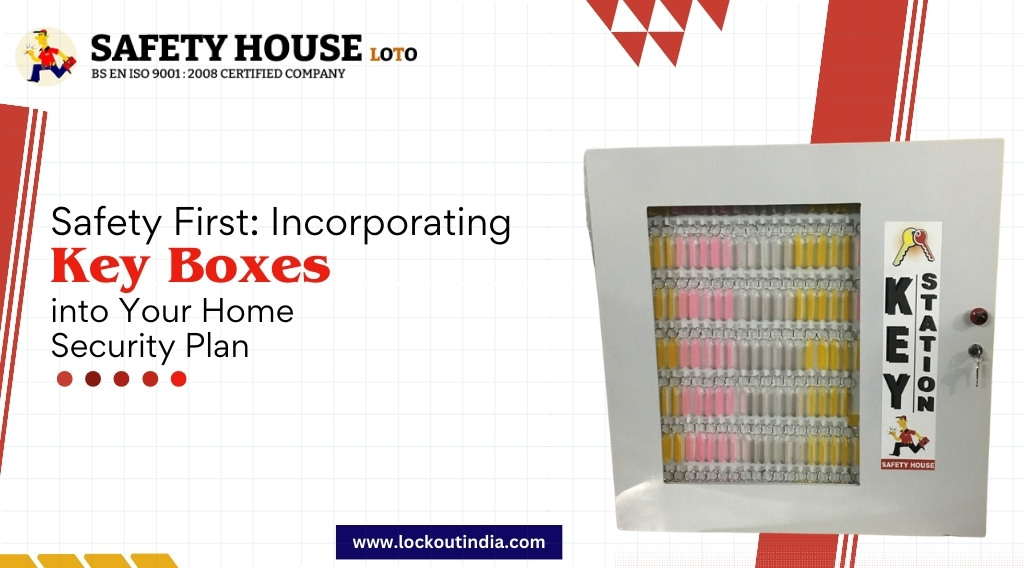
Safety First: Incorporating Key Boxes into Your Home Security Plan
Ensuring the safety of our homes and loved ones is paramount in today’s world. With advancements in technology, homeowners have access to a plethora of security measures to protect their properties. One such measure gaining popularity is the use of key boxes. In this article, we will delve into the importance of key boxes in home security and how they can be seamlessly incorporated into your security plan.
Understanding Key Boxes
A key box, also known as a lockbox or key safe, is a secure container designed to store keys securely. Typically made of durable materials like metal or hardened plastic, these boxes are equipped with combination locks or digital keypads to restrict unauthorized access. Key boxes come in various sizes and designs to accommodate different key types and quantities.
The Role of Key Boxes in Home Security
Key boxes play a pivotal role in bolstering home security in several ways:
- Convenient Access for Authorized Individuals: Key boxes provide a secure means for authorized individuals, such as family members, trusted friends, or service providers, to access the property when needed. This eliminates the hassle of hiding spare keys in vulnerable or easily accessible locations, reducing the risk of unauthorized entry.
- Emergency Situations: In cases of emergencies, such as medical crises or house-related emergencies, key boxes enable swift access for first responders or emergency personnel. This can be crucial in situations where immediate access to the property is necessary to prevent further harm or damage.
- Enhanced Security: By storing keys in a secure lockbox, homeowners can mitigate the risk of unauthorized entry resulting from lost or stolen keys. Key boxes are designed to withstand tampering attempts, providing an additional layer of security for your property.
- Remote Access Control: Some advanced key boxes feature remote access capabilities, allowing homeowners to grant temporary access codes or monitor access logs remotely via smartphone apps or online platforms. This level of control enhances security by enabling homeowners to manage access to their property from anywhere, at any time.
Incorporating Key Boxes into Your Home Security Plan
Now that we understand the importance of key boxes in home security, let’s explore how you can effectively incorporate them into your security plan:
1. Evaluate Your Security Needs
Assess your specific security requirements, considering factors such as the size of your property, the number of occupants, and any existing security measures in place. This will help determine the type and size of key box best suited to your needs.
2. Strategic Placement
Select strategic locations to install key boxes, ensuring they are easily accessible to authorized individuals yet discreet enough to avoid detection by potential intruders. Common placement options include near entry doors, garage entrances, or in proximity to security cameras for added surveillance.
3. Choose a Secure Locking Mechanism
Opt for key boxes equipped with robust locking mechanisms, such as combination locks or electronic keypads, to prevent unauthorized access. Avoid using easily guessable codes or passwords and regularly update them for added security.
4. Regular Maintenance and Monitoring:
Periodically inspect and maintain your key boxes to ensure they remain in optimal condition. Check for signs of wear and tear, corrosion, or attempted tampering, and promptly address any issues to maintain their effectiveness.
5. Educate Authorized Users:
Educate all authorized individuals on the proper use of key boxes, emphasizing the importance of keeping access codes or combinations confidential and securely managing keys. Encourage regular review of access permissions to revoke access for individuals who no longer require it.
Conclusion
Incorporating key boxes into your home security plan is a proactive step towards safeguarding your property and loved ones. By providing convenient yet secure access to your home, key boxes offer peace of mind knowing that authorized individuals can enter when needed while deterring unauthorized entry attempts. Remember to carefully evaluate your security needs, strategically place key boxes, choose robust locking mechanisms, and regularly maintain and monitor their condition. With these measures in place, you can enhance the overall security of your home and enjoy greater peace of mind.
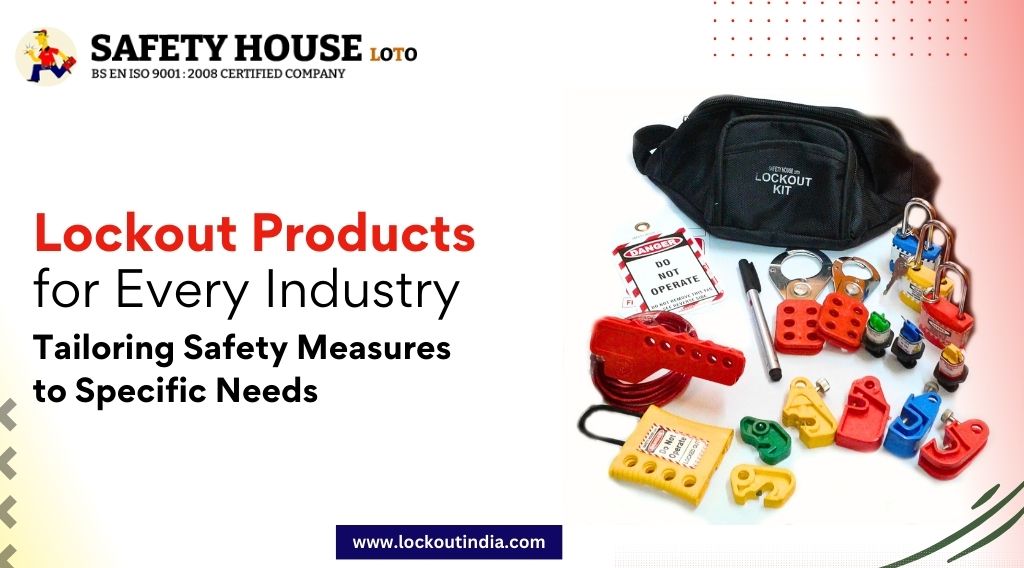
Lockout Products for Every Industry: Tailoring Safety Measures to Specific Needs
Empower Your Safety: Lockout Products for Every Industry
In today’s fast-paced industrial landscape, ensuring workplace safety is paramount. One critical aspect of safety protocols is the implementation of lockout procedures to prevent accidents and protect workers from hazardous energy sources. Lockout products are vital in these procedures, providing reliable solutions to secure machinery, equipment, and systems. Let’s delve into lockout products, exploring their importance across various industries and how they can be tailored to meet specific safety needs.
Understanding Lockout Products
Lockout products encompass various devices designed to isolate energy sources and prevent unauthorized access to machinery and equipment during maintenance or repair. These products typically include lockout/tagout (LOTO) devices such as padlocks, lockout hasps, valve lockouts, electrical lockouts, and lockout tags. Each of these devices serves a unique purpose in ensuring effective lockout procedures.
- Padlocks – Padlocks are versatile locking devices commonly used in lockout procedures. They provide a secure means of locking out energy sources by preventing the operation of equipment or machinery. Padlocks Lockout come in various sizes, colours, and materials, allowing for customization based on specific safety requirements.
- Lockout Hasps – Lockout hasps are designed to facilitate group lockout procedures by allowing multiple workers to apply their padlocks to a single energy isolation point. This ensures that equipment remains securely locked out until all maintenance or repair work is complete and all personnel are safely clear of the area.
- Valve Lockouts – Valve lockouts are essential for isolating energy sources in pipelines and machinery with rotating or linear valves Lockout. These devices effectively prevent valves’ accidental or unauthorized operation, ensuring that hazardous substances or energies are safely contained during maintenance activities.
- Electrical Lockouts – Electrical lockout devices are designed to isolate electrical energy sources, such as circuit breakers, switches, and plugs. By securely covering or locking out these components, electrical lockouts prevent the risk of electrocution or electrical accidents during maintenance or servicing.
- Lockout Tags – Lockout tags provide crucial information regarding the status of locked-out equipment or machinery. These tags are affixed to lockout devices to communicate essential details such as the reason for the lockout, the responsible personnel, and the expected duration of the lockout period. Lockout tags enhance workers’ communication and awareness, ensuring compliance with safety procedures.
Importance of Lockout Products in Every Industry
Regardless of the industry, implementing effective lockout/tagout procedures is essential for protecting workers from hazardous energy sources. Here’s how lockout products are indispensable across various sectors:
1. Manufacturing Industry
Lockout products are used in manufacturing facilities to safeguard machinery and equipment involved in production processes. From heavy machinery to conveyor systems and robotic equipment, lockout procedures prevent unexpected startup or release of stored energy, minimizing the risk of workplace accidents.
2. Construction Sector
Construction sites often feature a wide array of equipment and machinery, including cranes, excavators, and power tools. Lockout products are employed to isolate energy sources and control hazardous energy during maintenance, repair, or servicing activities, ensuring the safety of construction workers on-site.
3. Oil and Gas Sector
The risk of hazardous energy release is particularly high in the oil and gas industry, where operations involve high-pressure pipelines, valves, and machinery. Lockout products such as valve lockouts and electrical lockouts are instrumental in preventing accidents and maintaining a safe working environment for personnel involved in drilling, refining, and transportation activities.
4. Healthcare Facilities
Even in healthcare settings, where the focus is on patient care, the use of medical equipment and machinery poses inherent risks to staff and patients alike. Lockout products play a crucial role in ensuring the safe operation and maintenance of medical devices, such as diagnostic equipment, surgical instruments, and imaging machines, reducing the likelihood of accidents or malfunctions.
5. Automotive Industry
In automotive manufacturing plants, where precision machinery and robotic systems are utilized in assembly lines, the implementation of lockout procedures is essential to protect workers from moving parts and electrical hazards. Lockout products enable maintenance teams to safely service equipment without risking injury or disruption to production schedules.
Tailoring Lockout Solutions to Specific Industry Needs
While the fundamental principles of lockout/tagout procedures remain consistent across industries, the specific requirements and challenges may vary. As such, it’s essential to tailor lockout solutions to meet the unique safety needs of each industry.
- Customization Options – Many lockout product manufacturers offer customization options to accommodate industry-specific requirements. This may include the ability to engrave padlocks with company logos or employee identification numbers, colour-coding lockout devices for easy identification, or designing specialized lockout devices for unique machinery or equipment configurations.
- Training and Education – Effective implementation of lockout procedures relies on comprehensive training and education for personnel at all levels of the organization. Industry-specific training programs can ensure that workers understand the importance of lockout/tagout procedures, know how to identify energy sources, and are proficient in the use of lockout devices.
- Compliance with Regulations – Different industries may be subject to specific regulatory standards governing lockout/tagout procedures. Organizations need to stay updated on relevant regulations and ensure compliance with applicable standards to maintain a safe working environment and avoid potential fines or penalties.
Conclusion
In conclusion, lockout products are crucial in safeguarding workers and preventing accidents in various industries. Effective lockout tagout produts procedures are essential for protecting personnel from hazardous energy sources, from manufacturing plants to construction sites, healthcare facilities, and beyond. Organizations can create safer work environments and prioritize employee well-being by tailoring lockout solutions to meet specific industry needs and ensuring compliance with regulatory standards. Investing in high-quality lockout products and implementing robust safety protocols is not only a legal requirement but also a moral imperative to protect the lives and livelihoods of workers across industries.





